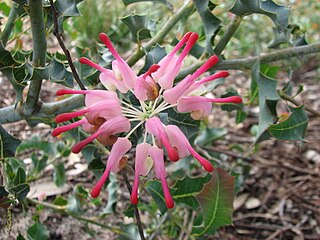
Grevillea intricata is a species of flowering plant in the family Proteaceae and is endemic to the west of Western Australia. It is a densely-branched shrub with tangled branchlets, divided leaves with linear lobes and clusters of pale greenish-white to light cream-coloured flowers.

Isopogon adenanthoides, commonly known as the spider coneflower, is a plant in the family Proteaceae and is endemic to the southwest of Western Australia. It is an erect shrub with sharply-pointed, trifid leaves and spherical heads of pink flowers.

Grevillea acrobotrya is a species of flowering plant in the family Proteaceae and is endemic to the southwest of Western Australia. It is a prickly, spreading to erect shrub with egg-shaped to trowel-shaped leaves with sharply-tipped lobes, and white to cream-coloured flowers with smaller leaves at the base.
Persoonia rufiflora is a species of flowering plant in the family Proteaceae and is endemic to the south-west of Western Australia. It is an erect, sometimes spreading shrub with hairy young branchlets, lance-shaped to linear leaves, and hairy, greenish yellow flowers arranged singly or in pairs.

Grevillea insignis, commonly known as wax grevillea, is a species of flowering plant in the family Proteaceae and is endemic to the south-west of Western Australia. It is an erect, bushy shrub with more or less oblong leaves with seven to seventeen sharply-pointed, triangular teeth, and more or less spherical or cylindrical clusters of cream-coloured flowers ageing to pink.

Persoonia saundersiana is a species of flowering plant in the family Proteaceae and is endemic to the south-west of Western Australia. It is an erect, spreading shrub with hairy young branchlets, linear leaves, and bright yellow flowers borne in groups of up to twenty-five on a rachis up to 100 mm (3.9 in) that continues to grow after flowering.

Grevillea erinacea is a species of flowering plant in the family Proteaceae and is endemic to the south-west of Western Australia. It is a spreading shrub with deeply-divided leaves with three to five linear lobes, rotated through 90°, and cream-coloured flowers with a white style.

Petrophile axillaris is a species of flowering plant in the family Proteaceae and is endemic to the south-west of Western Australia. It is a shrub with pinnately-divided, sharply-pointed leaves, and spherical heads of hairy pink or grey flowers.

Petrophile biternata is a species of flowering plant in the family Proteaceae and is endemic to the south-west of Western Australia. It is a shrub with biternate or pinnate, sharply-pointed leaves, and oval or spherical heads of glabrous, sticky, yellow flowers.
Petrophile chrysantha is a species of flowering plant in the family Proteaceae and is endemic to the south-west of Western Australia. It is a small shrub with crowded, sharply-pointed, pinnately-divided leaves, and oval heads of hairy, cream-coloured to dark yellow flowers.
Petrophile clavata is a species of flowering plant in the family Proteaceae and is endemic to the south-west of Western Australia. It is a shrub with curved, needle-shaped, sharply-pointed leaves and spherical heads of hairy, cream-coloured to very pale yellow flowers.

Petrophile conifera is a species of flowering plant in the family Proteaceae and is endemic to the south-west of Western Australia. It is a bushy, much-branched shrub with pinnate, sharply-pointed leaves, and oval heads of hairy, cream-coloured to yellowish white flowers.

Petrophile drummondii is a species of flowering plant in the family Proteaceae and is endemic to southwestern Western Australia. It is a shrub with rigid, pinnate leaves with needle-shaped, sharply-pointed pinnae, and spherical heads of hairy, fragrant, yellow flowers.
Petrophile incurvata is a species of flowering plant in the family Proteaceae and is endemic to southwestern Western Australia. It is a shrub with flattened, sometimes pinnately-divided leaves with up to five sharply pointed lobes, and cylindrical to oval heads of silky-hairy, cream-coloured to yellowish-white flowers.

Petrophile plumosa is a species of flowering plant in the family Proteaceae and is endemic to southwestern Western Australia. It is a shrub with rigid, sharply-pointed, sometimes lobed leaves, and more or less spherical heads of hairy, pale yellow flowers.

Petrophile rigida is a species of flowering plant in the family Proteaceae and is endemic to southwestern Western Australia. It is a shrub with rigid, branched, needle-shaped, sharply-pointed leaves, and more or less spherical heads of hairy yellow flowers.

Isopogon tridens, commonly known as the three-toothed coneflower, is a species of flowering plant in the family Proteaceae and is endemic to the southwest of Western Australia. It is a shrub with wedge-shaped leaves with two or three sharply-pointed teeth, and flattened-spherical heads of glabrous creamy white, sometimes purple flowers.

Isopogon villosus is a species of flowering plant in the family Proteaceae and is endemic to southwestern Western Australia. It is a tufted shrub with cylindrical leaves with twenty-five to thirty-two widely diverging lobes, and oval heads of cream-coloured to yellow flowers.

Isopogon inconspicuus is a plant in the family Proteaceae and is endemic to the southwest of Western Australia. It is a small shrub with pinnate leaves with cylindrical leaflets, and pink to purple flowers covered with grey hairs.
Petrophile globifera is a species of flowering plant in the family Proteaceae and is endemic to southwestern Western Australia. It is a shrub with more or less cylindrical leaves and elliptic to spherical heads of cream-coloured to pale yellow flowers on the ends of branchlets.














